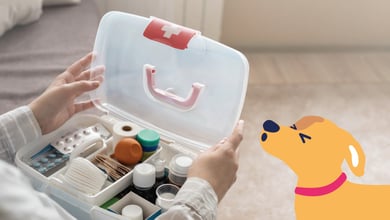Pet First Aid Tips: Ultimate Guide

Owning and caring for a pet comes with lots of "what ifs." Whether you're a first-time pet parent or a seasoned pet parent, educating yourself on general pet first aid can help you manage any adverse situations that may arise.
From having the right supplies on hand to knowing basic pet first aid procedures, there's plenty you can do to prepare for common injuries or emergencies. Be ready to accommodate your pet with these handy first-aid tips for pet parents.
Have a Pet First Aid Kit Available
Before diving into the pet first aid tips, make sure you have the necessary supplies on hand to help your pet in the event of an emergency. Use this pet first aid supplies checklist to start putting together a basic pet-friendly first aid kit for your home.
A pet first aid kit contains basic medical supplies for animals, such as gauze, a thermometer, and over-the-counter antibiotic ointment. If there is a medical emergency, you'll be glad to have all the supplies you need in one easily accessible location.
Should you have questions about putting together a complete first aid kit for your pet, your BetterVet veterinary doctor can assist during a virtual veterinary consultation. If you prefer to speak with your BetterVet veterinarian in person, we also offer stress-free home visits.
Are You a Pet Safety Expert?
1. Which one of the plants below is toxic to cats if ingested?
2. Which of the foods below is generally considered safe for your dog to eat?
3. Above what temperature is too hot to leave a pet in your car?
4. Which kind of leash is the safest to walk your dog?
5. True or False: If a medication is safe for humans, it is probably safe for pets.
6. What should you do if you think your pet ate something toxic?
View Results
Are You a Pet Safety Expert?
1. Which one of the plants below is toxic to cats if ingested?
2. Which of the foods below is generally considered safe for your dog to eat?
3. Above what temperature is too hot to leave a pet in your car?
4. Which kind of leash is the safest to walk your dog?
5. True or False: If a medication is safe for humans, it is probably safe for pets.
6. What should you do if you think your pet ate something toxic?
Share Quiz
Basic Pet First Aid Procedures
Knowing the basic procedures of first aid for pets is a great step for every pet parent. Explore these basic protocols for common injuries you can address at home, such as minor wounds, as well as CPR for pets.
Minor wounds
If your pet has suffered a minor cut or wound, you'll likely be able to treat this at home (with the proper supplies). Any minor wound should be rinsed with warm water to remove any debris from the opening. To stop the bleeding, cover your pet's wound with a piece of gauze or a clean cloth, and apply pressure.
After the bleeding has stopped, clean the wound with a safe antiseptic solution and a layer of over-the-counter antibiotic ointment. Once you have thoroughly cleaned the wound, apply a pet-friendly bandage. If the wound will not stop bleeding or is too big to tackle, seek help from a BetterVet veterinary doctor promptly. We offer same-day and next-day visits for non-emergency veterinary concerns.
Sprained or strained muscles
At one point or another, both humans and pets experience minor muscle injuries. Does your pet seem sore or tense? It may be suffering from sprained or strained muscles. If you think your pet is in pain, try placing an ice pack or a heating pad over the injured region. This can help reduce inflammation and take the edge off the pain. If your pet's muscle injury does not improve within a few days, schedule a sick visit with BetterVet.
Keep important contact information accessible
Learning general pet first aid tips can be helpful for addressing any minor injuries or illnesses your pet may experience. However, you also need to keep critical contact information accessible in case a more serious medical emergency occurs. Creating a contact card that includes the address and phone information for the local animal clinic and the Animal Poison Control Center is an important measure in keeping your pet safe. Make sure to store it in a place where you can get to it quickly.
Pet parents concerned about poisoning may find it helpful to keep activated charcoal in the home. But remember, this is only to be used as directed by your veterinary doctor or Animal Poison Control.
To help prevent poisoning in the first place, familiarize yourself with common household items that are toxic to pets.
Frequently Asked Questions
How do I know if my pet is experiencing heatstroke?
Heatstroke in pets is a common yet serious medical concern. If your pet is panting heavily, breathing rapidly, or drooling excessively, it may be experiencing heatstroke. Other signs of heatstroke include a fast heart rate and/or visible distress. Pet first aid tips for heatstroke include turning on fans, applying damp towels, and immediately moving the animal to a cooler location.
Who should I call if I'm not sure what to do?
When in doubt, it is always wise to seek care from a professional veterinary doctor. If you believe your pet is experiencing serious or life-threatening symptoms, seek help from the nearest animal emergency clinic or hospital immediately. For non-emergent symptoms such as lethargy, minor vomiting, or diarrhea, schedule a sick visit with BetterVet for more help.
How do I transport my injured pet?
It's best to keep your injured pet confined to a small area during transportation. This will help to reduce the risk of additional injury. Many pet parents find that using a pet carrier or cage works well. Place blankets or sheets down on the bottom of the carrier to add comfort for your pet during transport.
It may also be helpful to schedule an in-home visit with a BetterVet veterinary doctor, especially if your pet is unable to move around well.
Learn More First Aid Tips From BetterVet
Knowing how to properly help your pet in an emergency is part of your role as a pet parent. Staying up to date on pet first aid tips can help you feel more confident in the event of a minor pet injury.
Have specific questions about basic first aid for pets? A BetterVet veterinary doctor can answer your questions and provide additional first-aid tips during your pet's wellness exam.
Annual wellness exams are essential for keeping your pet happy and healthy. Most of our locations offer same-day or next-day availability, designed to work around your schedule. Book an appointment online today.






![Preparing Your Pet for Daycare or Boarding [Printable Checklist]](https://bettervet.com/hs-fs/hubfs/pet-boarding-facility-employee-playing-with-dog.png?width=420&height=220&name=pet-boarding-facility-employee-playing-with-dog.png)